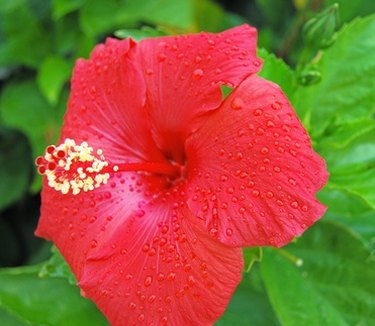
Hibiscus are paper-petaled bright flowering plants that add a tropical touch to any location. They are reminiscent of Hawaii and require warm temperatures and sun. Commonly grown as houseplants, you can move hibiscus outdoors in summer, but some hardy hibiscus can survive winter temperatures. Related to the mallows, which are grown as perennials in most zones of the United States, both indoor and outdoor hibiscus are prone to pests.
Pink Hibiscus Mealybug
Video of the Day
Found in the Caribbean in 1994, pink hibiscus mealybug has since migrated to the United States and other areas with the importation of plants. The bug affects many tropical plants, including citrus trees, but the name is indicative of where it probably originated. As the mealybug feeds on the plant's sap, it injects a toxic compound in its saliva. This causes contorting of the leaves of the Hibiscus. Eventually the twigs will twist and even the flowers will be affected. The Pink mealybug is a very serious pest of tropical and semi-tropical areas.
Video of the Day
Conditions
Several conditions can cause leaf curl. Plants can be very finicky about where they grow. Too much sun can cause the leaves to try to curve away to protect themselves from scald. Too little sun will make leaves curl toward the light. Plants show displeasure in improper cultivation methods such as improper water and nutritional deficiencies by contorting their leaves and sometimes even dropping them. Hibiscus foliage is an excellent indicator of plant needs.
Aphids
Aphids are a common problem of indoor and outdoor hibiscus. Aphids attack the terminal ends of branches where the newest leaves and buds grow. Continued presence of the pests will reduce the plants' vigor over time. Aphids are sucking insects that dine on the plant's sap. Their feeding activity can cause the leaves to curl and distort, finally yellowing and falling off the plant. Their waste is in the form of honeydew, a sticky substance that will show up on plants as sooty mold. The black furry stuff on leaves is a good indicator of an aphid infestation. Ants are also a clue since they will be present to dine on the honeydew.
Prevention and Control
Short, sharp bursts of water effectively handle insect pests; the spray washes off the pink mealybugs and aphids. For extreme infestations, an insecticidal soap is useful as a safe pesticide. Natural predators such as ladybugs and others are biological controls that dine on all phases of the mealybug and on adult aphids. Eliminating leaf curl on improperly managed plants requires the instigation of a careful care program. Grow hibiscus in morning sun and afternoon shade and use a hydrometer to gauge water needs. Test the soil annually for pH levels and nutrient content so you can amend it.